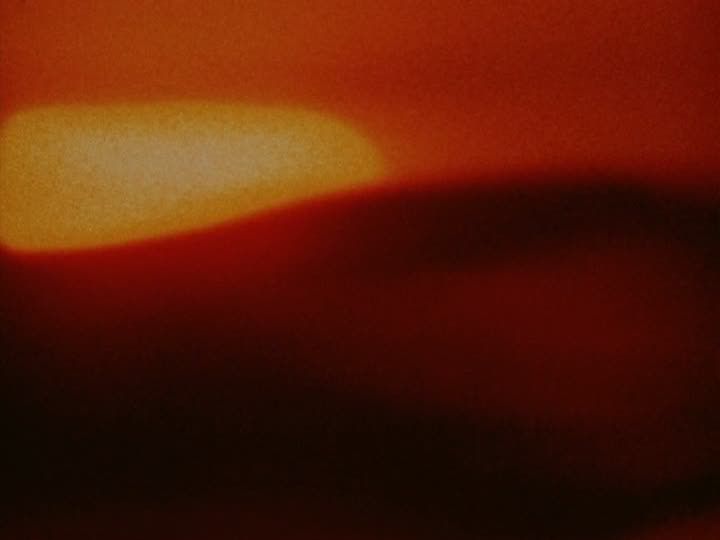
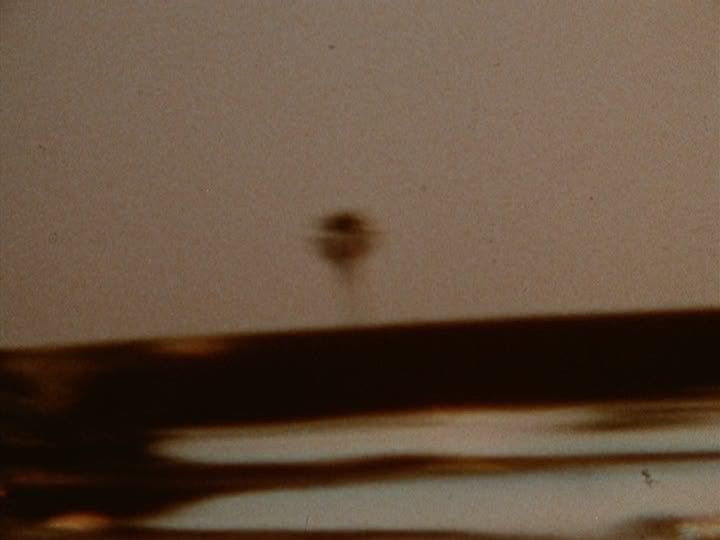
Desert is a phenomenally sensual, evocative film from Stan Brakhage. It is an examination of literal and metaphysical deserts, extracting the essence of the desert and exploring both the physical place and its abstract equivalent — red-hot sun, hazy heat-blurring, hallucinatory mirages, wavery color fields that suggest the horizon line dividing sand from sky. It is a film about deserts both external and internal, in keeping with Brakhage's insistence on the continuity between sensation, mental processes and the world outside. The film opens with images that are defined as desert-like only in relation to the film's title, scratched into celluloid in Brakhage's distinctive jittery handwriting just moments before. Without that context, there would be little suggestive of the desert about these abstracted fields of brown and gray, these Rothko-like color fields, divided by horizon lines that seem to shimmer in the distance. A red-brown haze is complicated by a pattern of cracks and cobbles that evoke images of dry desert hardpan. A dried-out, bare bush appears, with its spiky branches sticking up into the sky, looking like bones, a rib cage stretched out on the desert's empty ground.
This film is all about the landscape of the desert, and more a mental landscape than a tangible one. It feels like the desert. Watching it, one can feel the heat, can feel it in Brakhage's images of a shimmery yellow sun hovering in a red, gritty sky, the red thick with clusters of film grain. The landscape below is black and silhouetted, this dark land of hills and long dry plains stretched out beneath what seems to be an eternal red sky. At one point, Brakhage captures the sunset and, by placing his finger partially in front of the camera lens, distorts and warps the sun, compressing it into a flattened oval, expanding and contracting in the haze of the twilight hour. These kinds of distortions are at the heart of the film, distortions that evoke a kind of ideal desert, romanticized and haunting, the sun always in the process of setting, the land always bathed in deep shadows, the heat creating mirages that waver unpredictably at the edges of the frame, like the shot of what seems to be children playing, a flurry of unclear movement out of focus in the background. The children seem like ghosts, fuzzy afterimages that shift unpredictably in and out of view, only half-existing at the fringes of perception.

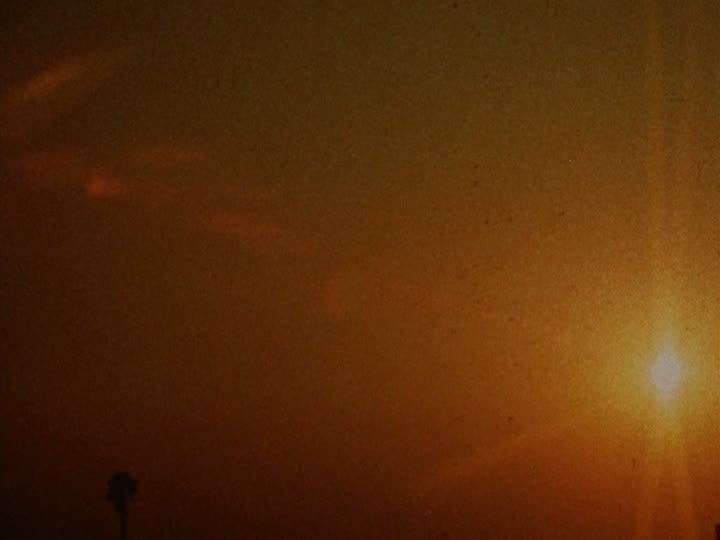
At other moments, Brakhage's images suggest a desert found within civilization: light flares shifting within an abstract space, occasionally taking form just enough to suggest that Brakhage was filming cars moving along a highway, the sun or their headlights creating reflections and star-like bursts in the grainy clouds. Brakhage captures the loneliness, the emptiness of the desert, the feeling of one lone leafy tree — an incongruous palm tree, symbol of fertility and tropicality, made to seem desert-like in its isolation — rising up out of the bare, dark hills. This is a very existentialist movie, because the desert seems to inspire such existential thoughts; there is something about the isolation of the desert that provokes the kind of bleak romanticism that Brakhage conveys so powerfully here. His images lack the clarity of specificity, though the film was shot on a trip to Southern California. There is no suggestion that this is a road trip movie, a document of a particular place or time. It is instead general, not to say generic. It is timeless rather than of its time.
In fact, Brakhage's actual locale, the place where the movie was shot, was not the desert, was in fact a tame suburban area, as seen occasionally in the shots of parking lots and highways. Brakhage is creating a mental desert out of nothing, shaping the space around him into an ideal desert where none existed in reality. Many of the film's textured shots might be interiors, even, shot out of focus in order to make them indistinct and abstract, so that they might be merged into Brakhage's desert fantasy.
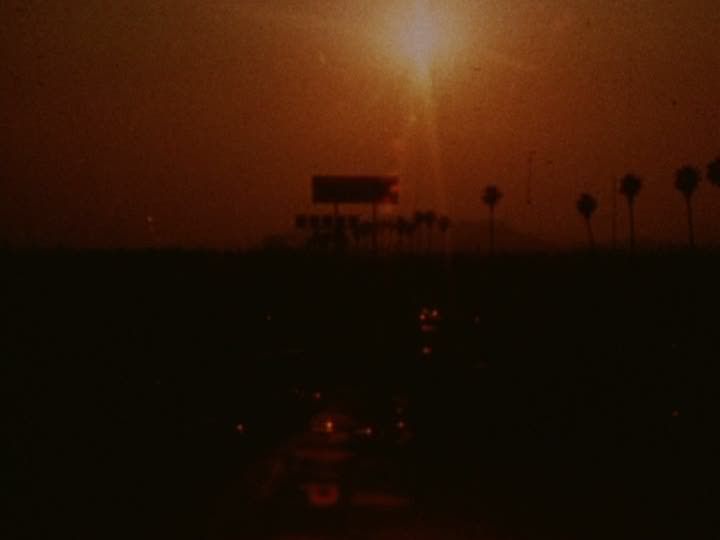
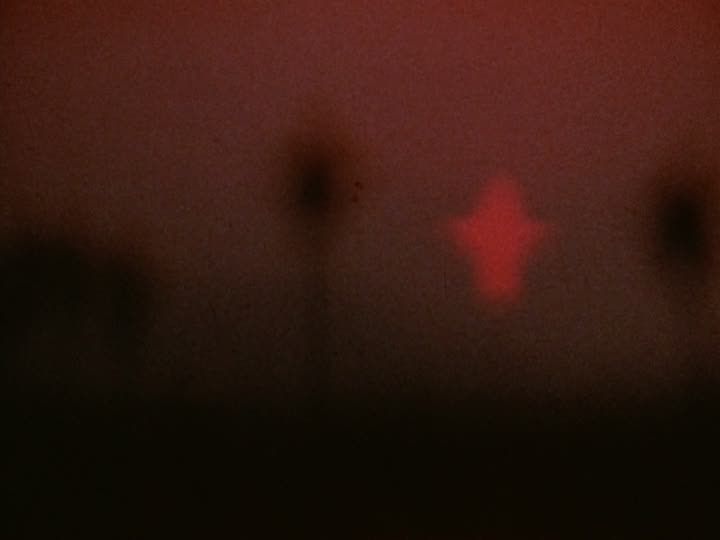
This is all leading towards the film's striking final image: the sun setting rapidly and, at the last moment, transforming into a blurred purple cross of light suspended just above the horizon, a moment of profound transcendence and beauty. It's a trick of light, the way the sun morphs and shifts over the course of its descent, culminating in this spiritually suggestive final image, but then these kinds of tricks of light are never just that for Brakhage. An illusion, a manipulation, is never just an illusion to Brakhage, who sees these evocative images as truthful representations of internal, if not external, realities. If a faked, manipulated desert landscape suggests spiritual inquiry and heightened emotional states, Brakhage's warped images will privilege that subjective perspective over the more objective depiction of actual physical landscapes.

5 comments:
Lovely stuff.
Thanks, David!
My exposure to Mr. Brakage is limited, and in the wide, wonderful world of cinematic wonderment, I'm afraid I haven't yet been truly touched by the magic here. Someday I will give this artist teh attention he so richly deserved, and I'll be able to come back here and applaud. One way to start of course would be the secure the Criterion Volume 2 DVD set. I do generally appreciate sensory and metaphysical elements in film.
Sam, I highly recommend anyone exploring Brakhage to some extent. The two Criterion sets are obviously amazing, just a treasure trove of great films culled from a truly massive career.
Great reflection of a movie that I love.
Post a Comment